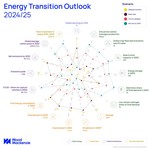News Release from Wood Mackenzie Ltd
Wind Industry Profile of
New global wind power life cycle emissions to reach 55 Mt CO2 from 2020-2050
According to Wood Mackenzie, a Verisk business (Nasdaq:VRSK), global wind power life cycle emissions will reach 55 million tonnes of carbon dioxide equivalent (Mt CO2) from 2020 to 2050, a result of wind power capacity expanding five-fold to 3.7 terawatts from 2020 to 2050. This is roughly equivalent to four times the US’s total power capacity in 2020.
Wind power does not generate emissions, but its life cycle - from raw material extraction through manufacturing and construction to end of life disposal - does. Up to 86% of wind power life cycle emissions are attributed to the extraction of raw materials and the manufacturing of wind turbines. This includes using metals such as steel, aluminium, and copper. The remaining 14% of emissions are contributed by transportation, installation, operations and maintenance (O&M), and decommissioning and disposal.
Wood Mackenzie principal analyst Robert Liew said: “To put into perspective, the total life cycle emissions of wind power make up only a tiny fraction of the 12 billion tonnes of CO2 released from all fossil fuel-based power generation in 2020.
“Wind power is the cleanest renewable power on life cycle emissions basis, and when compared to other technologies, it ranks second only to nuclear power. However, the latter’s capex costs can be two to three times more.”
The sources of electricity used in the manufacturing process can also make a difference in emissions reduction. Wind turbines manufactured in developed countries could potentially release up to 53% less emissions due to lower carbon intensity of grid power.
Wood Mackenzie estimates up to 60% of CO2 emissions could be reduced in the transport and O&M segments by the end of the decade. This is driven by larger turbine size resulting in fewer units and fewer trips needed to transport components to sites, improved fuel mileage of onshore transportation, greater use of electric vehicles, and turbine technology improvements reducing the frequency of site visits and better durability.
Liew said: “We expect the industry to be cautious in adopting new methods of wind turbine manufacturing and installations particularly the impact on levelised cost of electricity (LCOE). The recent surge in commodity prices in 2021 where steel prices have risen by 25% could lead to an increase in LCOE by between 3% and 5%, and turbine suppliers cannot absorb such high price increases.”
However, as more wind turbines reach the end of their life cycles, operators will need to plan for decommissioning and disposals. Wood Mackenzie expects total global decommissioning capacity to rise six-fold to 11 gigawatts by the end of this decade. Turbine blades will pose a challenge as composite materials are not easily recyclable and are currently being disposed by dumping. Fortunately, new policies are being considered to ban the use of landfill for blade disposal, and leading wind turbine companies are investing in new technology to recycle such composite materials.
Liew said: “Major global turbine suppliers are aiming to be carbon neutral in operations in the short term, with plans to decarbonise life cycle emissions in the long run.
“However, the elephant in the room is the indirect emissions derived from raw material extraction and manufacturing of steel and concrete. While it is still early days, the wind industry will be closely watching decarbonisation shaping in steel, mining and power sectors.”
Emissions from core materials such as steel and concrete will eventually become more efficient over time and help contribute to lower emissions as decarbonisation expands across all sectors. In the meantime, wind project developers aim to improve turbine efficiency and plant utilisation to maximise the supply of zero-carbon electricity to the grid.
Purchase the full report here.
- Source:
- Wood Mackenzie
- Author:
- Press Office
- Link:
- www.woodmac.com/...
- Keywords:
- Wood Mackenzie, life cycle emissions, CO2, wind turbine, wind farm, costs, renewable energy, nuclear, LCOE, capacity, terrawatts, raw material




























